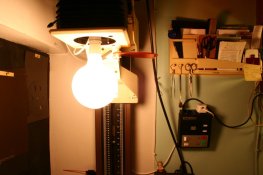DanielStone
Member
hey all,
I'm new to the LF scene, and have been enjoying it very much so far. 4x5 is what my budget can afford at this time, but I'm hoping to upgrade to an 8x10 when I can afford it. I've been contact printing 4x5 negs(both color and b/w) under the enlargers at school up until now, and enlarging sometimes, but I really like what I'm getting from the contact prints. Kind of hard to describe, but to me there seems to be a different quality about them.
I'm still at home while attending school(i'm 21), and my parents are really leery about chemistry in the bathtub. They say I should do all my photo stuff at school, but sometimes TV gets really boring at home after a while...
How many of you contact print with a simple light bulb, similar to how Weston and Ansel did for such a long time?
Also, I've been reading up on Weston's process, and Ansel said that his negatives were not really up to printing, they were much better for contact printing. I've been getting good(albeit not great yet) results with my basic times for TMY-2 and EFKE 25 in HC-110 or D76 1:1.
If any of you have had any experience doing this, and can recommend a special-wattage or type of bulb I'd need (I'm assuming a soft white, 40 or 60w)? Also, I'm guessing that adjusting contrast is somewhat out of the question, do to the fact that you're using a lightbulb, not an enlarger...
Thanks
Dan
p.s. I'm planning on only doing b/w at home, not color
I'm new to the LF scene, and have been enjoying it very much so far. 4x5 is what my budget can afford at this time, but I'm hoping to upgrade to an 8x10 when I can afford it. I've been contact printing 4x5 negs(both color and b/w) under the enlargers at school up until now, and enlarging sometimes, but I really like what I'm getting from the contact prints. Kind of hard to describe, but to me there seems to be a different quality about them.
I'm still at home while attending school(i'm 21), and my parents are really leery about chemistry in the bathtub. They say I should do all my photo stuff at school, but sometimes TV gets really boring at home after a while...
How many of you contact print with a simple light bulb, similar to how Weston and Ansel did for such a long time?
Also, I've been reading up on Weston's process, and Ansel said that his negatives were not really up to printing, they were much better for contact printing. I've been getting good(albeit not great yet) results with my basic times for TMY-2 and EFKE 25 in HC-110 or D76 1:1.
If any of you have had any experience doing this, and can recommend a special-wattage or type of bulb I'd need (I'm assuming a soft white, 40 or 60w)? Also, I'm guessing that adjusting contrast is somewhat out of the question, do to the fact that you're using a lightbulb, not an enlarger...
Thanks
Dan
p.s. I'm planning on only doing b/w at home, not color













 , I don't have the camera yet
, I don't have the camera yet 